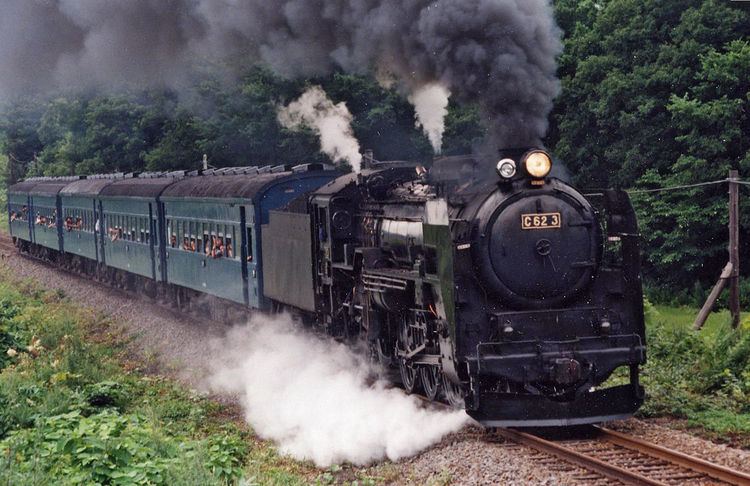Power type Steam Driver dia. 1,750 mm (5 ft 9 in) | Build date 1948-1949 Gauge 1,067 mm (3 ft 6 in) | |
 | ||
Builder Hitachi, Kawasaki Heavy Industries Rolling Stock Company, Kisha Seizō | ||
The Class C62 (C62形) is a type of 4-6-4 steam locomotive built by Japanese National Railways (JNR) in Japan. The C classification indicates three sets of driving wheels. The C62 was built with a 4-6-4 frame, upon which was mounted the boiler of the JNR Class D52 2-8-2 locomotives.
Contents
These were the largest and fastest steam passenger locomotives to run in Japan, and hauled the Tsubame (swallow) express on the Tōkaidō Main Line between Tokyo and Osaka. Only South Africa operated more powerful Cape gauge locomotives. Forty-nine C62s were built from 1948 to 1949. Five C62s hauled the Teine express in Hokkaido between Otaru and Hakodate after they were displaced by electrification of the Tōkaidō Main Line. Two locomotives were used to double-head trains on the 2.5% (1:40) grades between Otaru and Oshamambe where they were a popular tourist and railfan attraction until 1971. The last examples in regular service were withdrawn in 1973.
A class C62 locomotive, C62 17, broke the speed record for a narrow-gauge steam locomotive on 15 December 1954 when it reached 129 km/h (80 mph) on the Tōkaidō Main Line. This locomotive was preserved in a park in Nagoya, and later moved to the SCMaglev and Railway Park in Nagoya.
In popular culture
The C62 has achieved a level of fame due in part to the manga/anime series Galaxy Express 999, in which the express is pulled by an advanced space locomotive that is built to replicate a C62.
The founders of Hudson Soft (rail fan brothers Yuji and Hiroshi Kudo) were fond of the C62 and other 4-6-4 locomotives, so they named the company after them: 4-6-4 configuration locomotives are also known as Hudsons or Hudson-types. Japan picked up the term from the USA (where the first 4-6-4 built was named after the Hudson River), the C60, C61, and C62 used many American design elements and conventions in their designs, apparently including class names. Hudson Soft also named a number of products after the C62, including the development kit for the PC Engine, and a chip (Hu62) that was used in a later version of the hardware. It was also the code name for their console before they settled on PC Engine.
Preserved examples
As of 2012, five Class C62 locomotives were preserved at various locations around the country.
